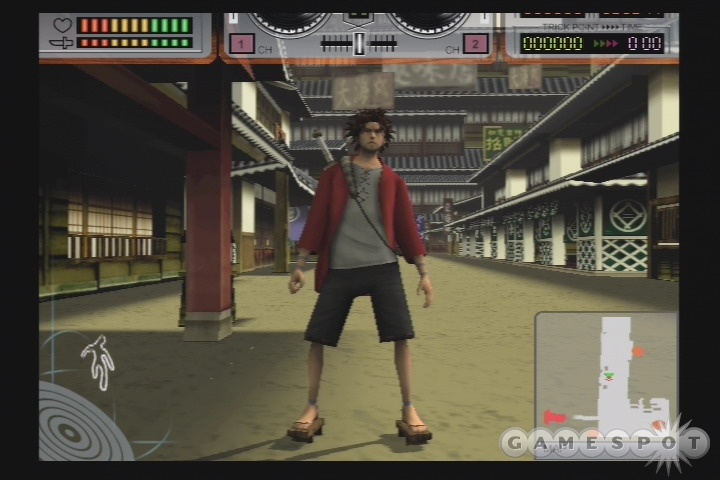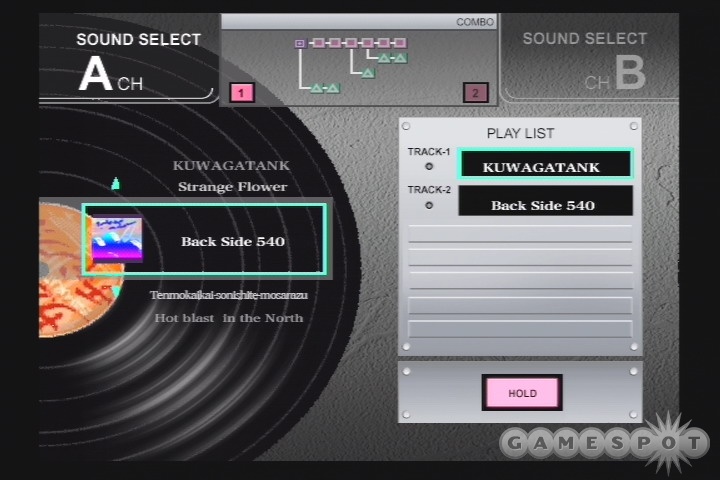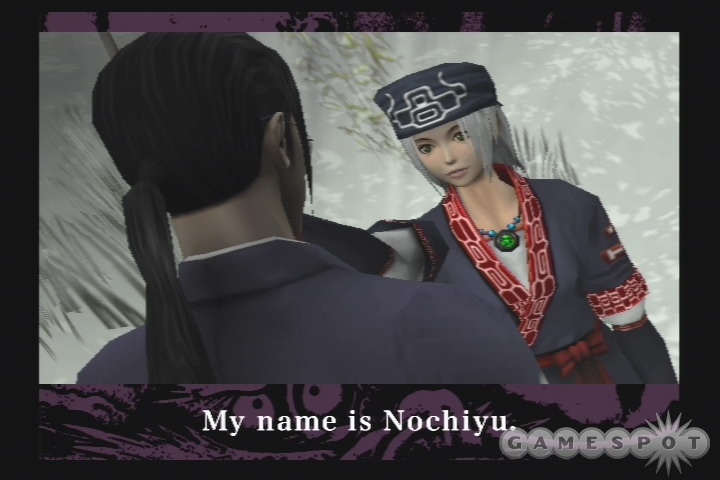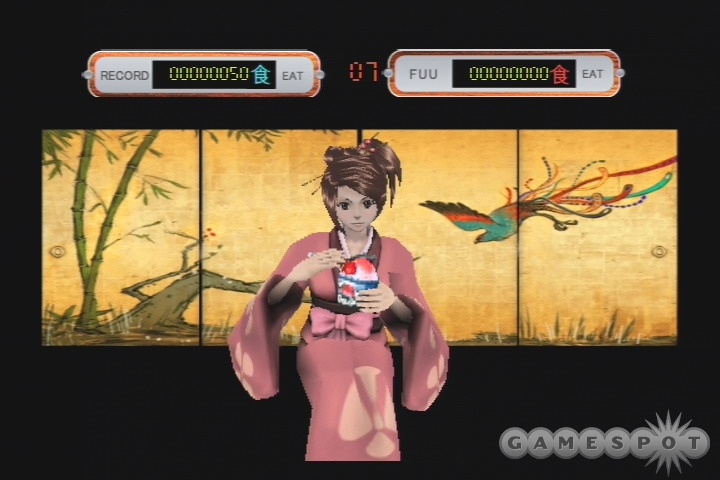Samurai Champloo: Sidetracked Updated Hands-On
We go hands-on with the "sons of a battle cry" in our latest look at this anime-inspired hack and slash for the PS2.
Samurai Champloo: Sidetracked is the first video game based on the hit anime series Samurai Champloo, which airs in America as part of Cartoon Network's Adult Swim late-night block of programming. The game focuses on the adventures of the show's three main characters--the stoic samurai Jin, the wild-haired swordsmen Mugen, and the former waitress Fuu--as they travel Edo-era Japan in search of a mysterious samurai who smells of sunflowers. In our last look at the game, we got a brief glimpse of the story and the mechanics. Now that we've had some more time with Sidetracked, we've got some updated details on just how this sword-swinging, hip-hop-laced adventure game plays out.

When you first start the game, you'll see a CGI take on the familiar opening sequence from the television show, complete with the trippy beats of the opening theme. A brief sequence introduces the three main characters and their quest to find the sunflower samurai. After that bit of formality, you hit the road with the trio, who are once again famished from many days of journeying. It isn't long before the three, tempted by the promise of "three hots and a cot," board a ship bound for Ezo. It's here that the main plot of the game is revealed.
In Sidetracked, the northern city of Ezo is embroiled in conflict between the ruling Matsumae clan and the native people who have lived in the area for generations. Oppressed by the ruling Matsumae, the strongest of the remaining native clans is the Tsurumaki, led by the mysterious Worso, a white-haired warrior who is a major player in Sidetracked's plot. In the game, you choose to play as one of the series' two sword-wielding protagonists. The stoic Jin is a master swordsman who relies on precision and blinding speed. Mugen's fighting style, on the other hand, is more akin to break-dancing with blades than any formal school of swordplay, and he's probably the easier character to start out with. Both characters have their own plot arcs to play through in the game.
As Jin, you start off in the heart of the Matsumae town. Venturing outside the city gates, Jin encounters a gigantic bear as he walks down a snowy path. Just before the massive beast can strike Jin down with one swipe of his paw, a young white-haired child murmurs a few magic words and drives the bear away. Indebted to the girl, Jin travels to her home and meets her caretaker, a giant of a man named Ranke. The girl, named Nochiyu, is the sister of Worso, and the pair possess two rare gems whose combined power is feared and lusted after by the ruling Matsumae clan.
Mugen's adventure begins after he encounters a strange witch who is intent on defeating him, going so far as to conjuring a snake from thin air and firing it into his mouth. Now cursed and poisoned, Mugen is nursed back to health by Worso, who then informs Mugen that the only way to lift the curse is to hunt down the witch. This prospect, as Mugen finds out as the game progresses, is easier said than done.
While both character's paths initially diverge, there are moments when you meet up with your counterpart as the story unfolds. Early in the game, for example, both Jin and Mugen end up inside the same burning building while pursuing their separate agendas. Before the pair can start hacking each other apart (let's just say they aren't exactly best buddies, these two), they are interrupted by Worso, who has an agenda of his own.

In addition to having divergent plots, both characters' fighting styles and controls are different. For one thing, their sword combos are different from one another. As a result, both characters have special attacks and moves that are unique to them--Mugen can leap great heights, for example, while Jin often uses rolls in his combat combos. Sidetracked uses an interesting music-based fighting system that lets you have access to different combo chains depending on the music playing in the background at any given moment. You have access to two records for any given mission, and you can buy more tunes in local record shops found in towns. While in combat, you can switch back and forth between the two by pressing left or right on the right analog stick which, as a result, will change your active combo tree.
Combos aren't just dictated by the soundtrack, however; the amount of tension also affects which button combos are available to you. The more blows you land against an opponent, the higher the tension level goes (indicated by a pulsing speaker in the lower left-hand corner of the screen). The tension level is reduced if you're struck by an opponent, so as long as you're pummeling your foes, you'll keep the flow going. Once the tension meter reaches its maximum, a star will appear over an opponent's head. Strike that opponent, and you'll immediately go into tate mode, a fighting minigame where you first press the button shown onscreen and then try to land as many blows on your opponent as possible. How many successful strikes you make dictates the amount of health your character regains when returning back to the normal combat mode.

Finally, should you hit your foe more than 100 times in tate mode, you'll move into a supremely strange fight mode that challenges you to defeat 100 opponents without being killed. Do so successfully, and you'll unlock hidden artwork or new weapons to purchase in the store. There's no doubt this final minigame mode is interesting to look at and listen to--with its silhouetted characters against brightly colored Japanese screen backgrounds and its bouncy techno music--but honestly, it wears thin after a few tries. Still, if you're looking to unlock everything the game has to offer, you'll want to make sure you keep those buttons mashed during this stylish and speedy mode.
As for the main flow of combat, you can expect to face multiple enemies in one long stretch, none of whom are that intent on doing you much harm early in the game. Using the R1 button, you can center on a single foe at a time, which is a handy addition considering Mugen's wild fighting style. With combos, you'll spend most of your time with the square and triangle buttons, though Jin's slightly more complicated stances do make use of the circle and X buttons. The combo tree for your current tune is always onscreen, so you can design the kind of attack you want at any time. At times, certain points on the combo tree are illuminated. If you perform that combo, you'll enter "hyper" mode, which will let you put a quick pounding on a foe. Maximizing "hyper" time is a key element in boss battles, because it lets you get in multiple hits before the boss even knows what hit him (or her).
In between battles and cutscenes, Jin or Mugen can roam the streets of Ezo, where you can find shops to upgrade your weapons, buy food that will give you attribute bonuses, or add to your record collection. There are even a handful of minigames to take part in, including an eating game starring Fuu and a strange beetle sumo contest where you can place bets on who you think will win. The relatively open-ended nature of the city is in contrast to the linear combat sequences, which have you hacking and slashing your way through constricted paths on your way to the next boss battle.

Perhaps one of the most difficult areas of Sidetracked to describe is the game's presentation. Much like the stylized anime it draws from, Sidetracked is a mishmash of styles: part traditional Japanese architecture, part hip-hop lingo and clothing, part tranquil snowy woods, and part MTV-style cuts between loading screens. During some battles, you're fighting with little or no background behind you, while every blow you land is accompanied by metallic slashes across the screen. In others, you're navigating the narrow confines of a wooded path, with little room to maneuver and plenty of enemies in your way. Even the camera angles are odd--some have an almost side-scrolling feel, while others show the action from a higher angle. In all, the presentation isn't likely to get boring anytime soon, even if it can sometimes be confusing.
By focusing on the interesting mixture of hip soundtrack, sly humor, and compelling visual style that fuels the Samurai Champloo anime, Sidetracked looks and sounds like few other hack-and-slash adventure games on the PlayStation 2. We'll be sure to bring you a full report on the game's pleasures and pitfalls in our full review.
Got a news tip or want to contact us directly? Email news@gamespot.com
Join the conversation